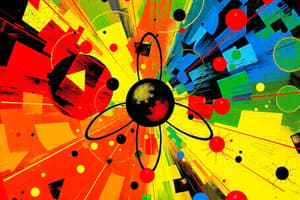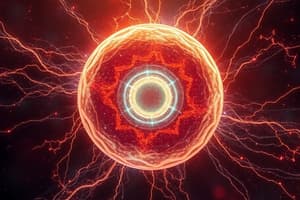Podcast
Questions and Answers
What is the percentage of the mass of the atom contributed by the nucleus?
What is the percentage of the mass of the atom contributed by the nucleus?
- more than 99.9% (correct)
- less than 0.01%
- exactly 50%
- about 50%
What is the symbol for the atomic mass unit?
What is the symbol for the atomic mass unit?
- gm
- u
- kg
- amu (correct)
What is the formula to estimate the atomic radius?
What is the formula to estimate the atomic radius?
- R = RoA^2
- R = Ro/A
- R = RoA^-1
- R = RoA^1/3 (correct)
What is the term used to describe atoms with the same number of protons but different numbers of neutrons?
What is the term used to describe atoms with the same number of protons but different numbers of neutrons?
What is the purpose of the inspection bodies for both the RR and PR reactors?
What is the purpose of the inspection bodies for both the RR and PR reactors?
What is the primary purpose of a research reactor?
What is the primary purpose of a research reactor?
What is the force responsible for binding protons and neutrons into atomic nuclei?
What is the force responsible for binding protons and neutrons into atomic nuclei?
What type of radiation is characterized by a charge similar to a neutron?
What type of radiation is characterized by a charge similar to a neutron?
What is the primary goal of nuclear physicists' research?
What is the primary goal of nuclear physicists' research?
What type of nuclei are typically used as fuel elements in nuclear reactions?
What type of nuclei are typically used as fuel elements in nuclear reactions?
Flashcards are hidden until you start studying
Study Notes
Nuclear Physics
- Studies atomic nuclei and their constituents, and interactions that hold them together
- Includes radioactive decay, fission, and fusion
- Strong nuclear force is responsible for binding protons and neutrons into atomic nuclei
- Strong nuclear force has a very short range (just a few femtometers)
- Unstable nuclides emit radiations spontaneously (α, β, and γ radiation)
Atomic Nucleus
- Positively charged central nucleus surrounded by negatively charged electrons
- Nucleus contains protons (positively charged) and neutrons (electrically neutral)
- Protons and neutrons are collectively called nucleons
- Mass of an electron is very small, so only the nucleus contributes to the mass of the atom
Nucleus Properties
- Mass number (A) is the sum of protons and neutrons in the nucleus
- Atomic number (Z) is the number of protons in the nucleus for a neutral element
- Atomic radius is estimated by R = RoA^(1/3), where Ro is the radius of the nucleus (1.2 × 10^(-15)m)
Nuclides and Isotopes
- A nuclide may be stable or unstable
- Unstable nuclides emit radiations spontaneously
- Isotopes are elements with the same number of protons but different numbers of neutrons
- Atoms with different numbers of neutrons are used to produce different types of radiation (α, β, and γ radiation)
Nuclear Reactors
- Research reactors (RR) are small and used to produce neutrons
- Power reactors (PR) are larger and used to generate electricity
- Both reactors are based on fission processes
- Fusion is still in progress in laboratories and computer work
Nuclear Safety
- Nuclear radiations have powerful ionization effects, which can be fatal to human beings if proper precautions are not taken
- Mandatory to use nuclear safety rules of the International Atomic Energy Agency (IAEA) for proper use of nuclear instruments and materials
- Separate inspection bodies are required for both RR and PR
Studying That Suits You
Use AI to generate personalized quizzes and flashcards to suit your learning preferences.




